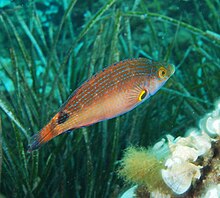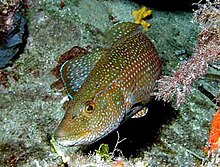Labrinae
| Labrinae | ||||||||||||
|---|---|---|---|---|---|---|---|---|---|---|---|---|

Cuckoo lipfish ( Labrus mixtus ) |
||||||||||||
| Systematics | ||||||||||||
|
||||||||||||
| Scientific name | ||||||||||||
| Labrinae | ||||||||||||
The Labrinae or Labrini are a taxon of the wrasse (Labridae), which, depending on the author, has the rank of a subfamily or a tribe .
distribution
The Labrinae are endemic in the northern Atlantic and with around 20 species of the genera Centrolabrus , Labrus and Symphodus in the Mediterranean .
The spotted wrasse ( Labrus bergylta ), the gold maid ( Symphodus melops ) and the rock perch ( Ctenolabrus rupestris ) also occur on the German North Sea coast. The occurrence of six East Atlantic species extends to the south coast of Norway , approximately to Florø . This makes them the furthest north living wrasse.
The genera Tautoga and Tautogolabrus live exclusively on the North American Atlantic coast from Newfoundland and Nova Scotia to South Carolina and Chesapeake Bay . They are the only wrasse that are important to the fishing industry.
nutrition
Like all other wrasse, the Labrinae feed on a large number of invertebrates , but some specialize in algae habitats and pluck their food from the algae clusters. That is why they always inadvertently ingest some plant-based food. For stomach examinations of Symphodus tinca were found amphipods , copepods , mites , snails , mussels , ostracods , foraminifera , nematodes , polychaetes , various crustaceans , midge larvae , small brittle stars , fish larvae and less vegetable than 10% ingredients such as algae and detritus of vegetable origin.
Reproduction
While all other wrasse are free spawners who do not practice brood care and release their germ cells into the open water, most Labrinae have developed a brood care behavior. Some species create hollows in the sandy bottom with quick strokes of their caudal fin, in which they lay their eggs. Other species, such as sticklebacks, build nests from algae and other plant material to lay eggs . The eggs are guarded by the male until the larvae hatch.
Systematics
Phylogenetically , the Labrinae are the sister group of an unnamed clade , to which the parrotfish (Scarinae) and the condominium fish (Cheilinini) belong.
Genera and species

- Acantholabrus Cuvier & Valenciennes, 1839
-
Centrolabrus Günther , 1861
- Centrolabrus caeruleus Azevedo, 1999
- Small-mouthed wrasse ( Centrolabrus exoletus ( Linnaeus , 1758) )
- Centrolabrus trutta (Lowe, 1834)
-
Ctenolabrus Valenciennes , 1839
- Rockfish ( Ctenolabrus rupestris (Linnaeus, 1758) )
-
Labrus Linnaeus, 1758
- Spotted Wrasse ( Labrus bergylta Ascanius, 1767 )
- Blackbird Wrasse ( Labrus merula Linnaeus, 1758 )
- Cuckoo Lipfish ( Labrus mixtus Linnaeus, 1758 )
- Green wrasse ( Labrus viridis Linnaeus, 1758 )
-
Lappanella Jordan, 1890
- Lappanella fasciata (Cocco, 1833)
- Lappanella guineensis Bauchot, 1969
-
Symphodus Rafinesque , 1810
- Scaled-cheek wrasse ( Symphodus bailloni (Valenciennes, 1839) )
- Gray wrasse ( Symphodus cinereus (Bonnaterre, 1788) )
- Symphodus doderleini Jordan, 1890
- Mediterranean wrasse ( Symphodus mediterraneus (Linnaeus, 1758) )
- Black-tailed wrasse ( Symphodus melanocercus (Risso, 1810) )
- Goldmaid ( Symphodus melops (Linnaeus, 1758) )
- Eye-spot wrasse ( Symphodus ocellatus (Forsskål, 1775) )
- Five-spotted wrasse ( Symphodus roissali (Risso, 1810) )
- Snouted wrasse ( Symphodus rostratus (Bloch, 1791) )
- Peacock wrasse ( Symphodus tinca (Linnaeus, 1758) )
-
Tautoga Mitchill , 1814
- Tautoga onitis (Linnaeus, 1758)
-
Tautogolabrus Günther, 1862
- Tautogolabrus adspersus (Walbaum, 1792)
- Tautogolabrus brandaonis (Steindachner, 1867)
swell
- Bent J. Muus, Jørgen G. Nielsen: The marine fish of Europe in the North Sea, Baltic Sea and Atlantic. Kosmos, Stuttgart 1999, ISBN 3-440-07804-3 .
- Matthias Bergbauer, Bernd Humberg: What lives in the Mediterranean? , 1999, Franckh-Kosmos Verlag, ISBN 3-440-07733-0
- S. Koblmüller, N. Duftner, C. Sturmbauer, H. Sammer, N. Ganther, R. Kopp, S. Voigt, B. Stadlbauer, A. Branstätter & R. Hanel: Comparative consideration of nutritional morphology and nutritional specificity of selected Mediterranean wrasse Species (Perciformes, Labridae) . In: Ber. nat.-med. Verein Innsbruck 90, 2003, pp. 219–230. ( PDF, 814kB , accessed on July 8, 2013)
